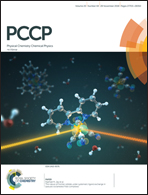Large magnetic anisotropy and its strain modulation in two-dimensional intrinsic ferromagnetic monolayer RuO2 and OsO2
Abstract
As a promising candidate suitable for applications in spintronic devices at the nanoscale and in high-density data storage, two-dimensional (2D) intrinsic ferromagnetic materials with magnetic anisotropy (MA) have been experimentally demonstrated in the last year. Monolayer RuO2 and OsO2 hold great potential for achieving large MA due to the strong spin–orbit coupling (SOC) interactions of Ru and Os. Using first-principles calculations, we systematically investigate the stability, electronic structure and magnetic properties of monolayer 1T-RuO2 and 1T-OsO2 and explore the effects of strain on their electronic structure and magnetic properties. It is found that both monolayer 1T-RuO2 and 1T-OsO2 are 2D intrinsic ferromagnetic materials with large MA. In particular, the magnetic anisotropy energy (MAE) of monolayer 1T-OsO2 is as high as −42.67 meV per unit cell and its Curie temperature is much higher than the liquid-nitrogen temperature. It is worth noting that the large MA of monolayer 1T-OsO2 is significantly enhanced by tensile strain. By analyzing the density of states and the d orbital-resolved MAE of Os and Ru atoms based on second-order perturbation theory, it is revealed that the large MAE of monolayer 1T-RuO2 and 1T-OsO2 is mainly contributed by the matrix element differences between the opposite-spin dxy and dx2−y2 orbitals of Ru and Os atoms, and the tensile strain induced enhancement of monolayer 1T-OsO2 mainly originates from the change in contributions to the MA from the matrix element differences between the dyz and dz2 orbitals of Os atoms from zero to negative. Our results indicate that monolayer 1T-RuO2 and especially monolayer 1T-OsO2 are promising candidates suitable for applications in spintronic devices at the nanoscale and in high-density data storage.



 Please wait while we load your content...
Please wait while we load your content...